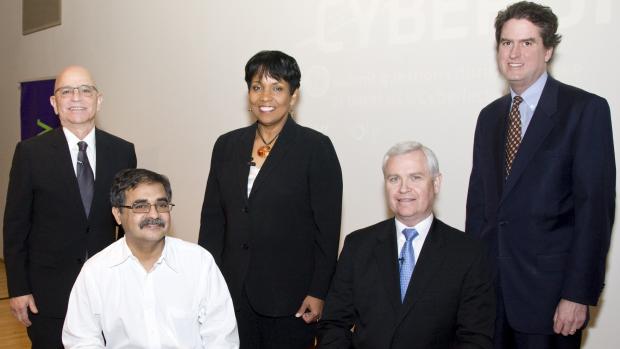Securing Our Future in Cyberspace and the Workplace

“You are going to be needed,” Jerry M. Hultin, President of the Polytechnic Institute of New York University (NYU-Poly), stated emphatically to students in the Pfizer Auditorium, where a crowd of three hundred from the NYU-Poly community and public cyber security sector had gathered for the second Sloan Cyber Security Lecture. In his opening remarks, Hultin stressed a simple point: a career in cyber security equals job security. Hultin also called for more women to consider it, citing the day’s Distinguished Lecturer, Debora Plunkett, Director of the Information Assurance Directorate for the National Security Agency, as an example. “She has a career we can all try to emulate,” Hultin said.
In her lecture, Plunkett echoed the sentiment. “I need fresh legs, and I see a lot of them here in the room,” she said. Plunkett, whose role involves defending national security systems, addressed emerging cyber security threats and mitigation strategy: with more technology used every day, “the more we need to protect it.” The core of her talk focused on defining emerging threats, why we should study them, and, touching back on the morning’s theme of careers in cyber security, “what opportunities exist for you as you leave this institution and go out into the work world.”
Bringing her lecture to a close, she emphasized the broad spectrum of new and growing threats, and that effective response strategies must target both the attacker and defender motivations. Academia and business must work together to respond effectively, crossing lines between “government, industry, and infrastructure.”
A panel discussion featuring Senior VP at Booz Allen Hamilton William J. Wansley, and Bill Phelps, a Managing Director in Accenture’s security practice followed the lecture. During the panel, moderated by Professor Nasir Memon, Phelps echoed Plunkett’s earlier comment about actively protecting cyberspace: we need to “build a fence to keep people out,” moving beyond defense. “For all the students, you’re in a great place,” he said. “There is zero unemployment in cyber security.”
In the hallway just outside the Pfizer auditorium, students displayed posters highlighting their research, showcasing cyber security compromise and dealing with threats and attacks. “Survivable Key Compromise in Software Update Systems,” by a group of students including NYU-Poly Vladimir Diaz and Konstantin Andrianov demonstrated the danger of compromise in software updates via a chart with principles for “Designing for Survivability.”
Jeyavijayan (JV) Rajendran, a graduate student in the Department of Electrical and Computer Engineering who presented “Security Analysis of Logic Obfuscation,” said the work “obfuscates the design” of “rogue elements in the supply chain” that pirate Integrated Circuits (ICs). “Only a correct key makes the design to produce correct outputs.”
“The Sloan lecture was great,” Rajendran added. It gave him “excellent feedback about our research” and “an experience about how to convey our research ideas effectively to others who might not be aware of that problem.”
“There’s a huge demand for cyber security right now, across the board,” said James Sillcox, Director at the Wasserman Center for Career Development at NYU-Poly. He pointed out that the research on display echoed material from the lecture, about the need for solutions in hardware as well as software. “The problems evolve and the solutions evolve with them. There’s an unmatched demand from this industry.”




